Props in rugby union are also known as prop forwards in rugby. You’ll also hear them called tighthead props or loosehead props.
This article explains the role of props in a rugby match and the differences between the two types.
We have separate articles on props in sevens rugby and props in rugby league. This article is about the fifteen-player sport. So, let’s start with the most basic question…
What Is A Prop In Rugby Union?
There are two props on the field in a rugby union team, the loosehead and the tighthead prop.
They are defined by their positions in the scrum. The loosehead is on the left of the front row and the tighthead is on the right.
Props are heavier players who lift in lineouts and protect rucks.
Props may not be the biggest players on the field as they are shorter than locks. However, they are often the heaviest and the strongest.
A typical prop has a wide squat build. They need raw strength primarily for their role in the scrum, which we’ll look at next.
Props In The Scrum
Scrums in rugby involve the eight forwards from each team scrummaging against each other.
Each team lines its forwards up in three rows. The two props wear the number one and number three jersey.
The hooker wears number two and packs down between the two props.
This diagram shows the scrum formation by number.
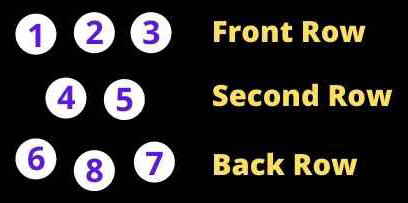
Of course, the front row wears the lowest numbers on the team.
This traditionally leads to jokes by their teammates about IQ levels (you can find plenty in this hilarious rugby joke book).
Loosehead Versus Tighthead Props
The names we give to forwards in rugby are largely based on their role in the scrum.
This diagram shows the names at their specific positions.
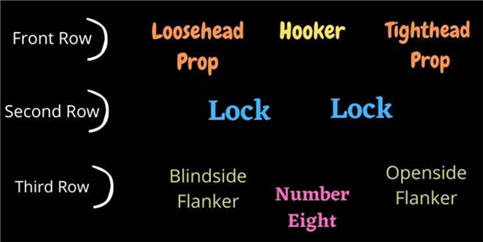
As you can see, the prop on the left of the front row is the loosehead prop. The prop on the other side is the tighthead prop.
If you struggle to remember which is which, here’s a handy phrase: “loose is left” and “tight is right”.
How Did They Get Their Names?
Prop forwards are called “props” because they “prop up” the scrum. Without them leaning against the opposition props, the scrum would collapse.
But what about tighthead and loosehead? These names come from where they put their heads when they scrummage. This is easier to explain with a picture.
Here is an overhead snap of a scrum in the 2022 Six Nations match between Scotland and England.
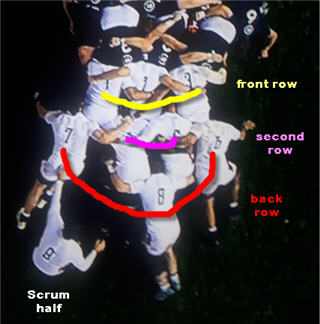
The England tighthead prop on the right has his head between the opposition loosehead and the hooker.
In contrast, the England loosehead prop only has his head pushed against the outside of the opposition tighthead.
This means that his head is “loose”, unlike the tightly wedged head of the number three.
This is why the prop on the left is called the loosehead prop and the prop on the right is called the tighthead prop.
It also means that they have different roles in the scrum.
Different Roles Of The Tighthead And Loosehead Prop In The Scrum
Now that we’ve established where the tighthead prop puts his head in a scrum, we can understand the different roles.
The tighthead is scrummaging between two opposition players instead of one. This means he is taking the pushing force of more players scrummaging against him.
Similarly, his teammates behind him send more of the entire pushing force of the pack through him.
This makes him the anchor of the scrum. The tighthead is often the strongest player on the field.
Of course, the loosehead has work to do too. Although less force passes through the loosehead, they have to provide power. Otherwise, the scrum will simply wheel around.
You’ll see this happen in matches where the loosehead gets overpowered. The scrum wheels or rotates to the left and usually collapses into a mess.
This can be a big win for the opposition if the referee awards them a penalty.
Roles Of Props In Lineouts
I’ve never seen a prop jump in a lineout in rugby union. They wouldn’t get too far off the ground, and they’d be difficult for other players to lift.
Check out our article that compares how heavy rugby players are across all positions. You probably won’t be surprised to see that the two prop positions are at the top of the chart.
However, props are usually the strongest players in a team. That means they have the very important role of lifting jumpers high into the air to catch the ball.
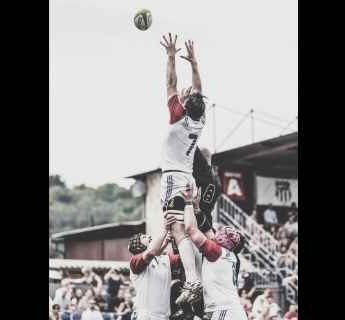
The Prop Positions Are Mandatory In The Scrum
If a flanker is sent off with a yellow or red card, you may see a winger packing down in the back row.
There is no law against the coach putting a tiny winger into the number eight position or even into the second row. (Although this foolish coach would probably be sacked!)
However, the prop forward positions are strictly regulated.
World Rugby insists that only players who have been correctly trained to scrummage can pack down in the front row.
Why are prop forward positions mandatory?
The prop positions are considered to be specialists and require expertise and training.
This is because an inexperienced prop could suffer serious neck or back injuries in a scrum that collapses.
The way this is enforced is that teams must nominate two players in the 22 or 23-player squad who can play in the front row. The list is provided to the referee.
This means that when a prop forward is substituted, only a nominated player can go into the scrum in that position.
What if the team runs out of front rows?
What if all the players who are nominated to be tighthead props get injured during the match?
Because these positions are mandatory, the referee will not allow a normal scrum to take place.
The answer is that “uncontested” scrums take place. The two teams still line up and pack down against each other. But they are not allowed to exert any force.
The Front Row Union
The rest of the pack, from three to eight, tend to think that the front row are hard as nails and a little bit nuts.
You’ll hear reference to the “dark arts” because they are the only guys who really know what is going on in the scrum.
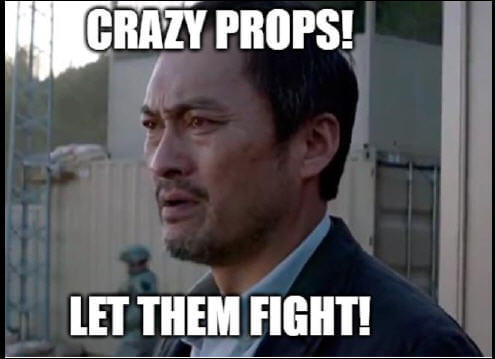
Experienced props learn little tricks to get the edge on the opposition and it’s very hard for the referee to see everything!
If you want to know more about the number two position in the front row, check out our article on the role of the hooker in rugby.
Are you familiar with some of the great names? We took ages to decide on the greatest loosehead props in recent times. Do you agree with our list?
Other Positions
Our high-level run through of rugby union positions has links to in-depth articles for each playing position.